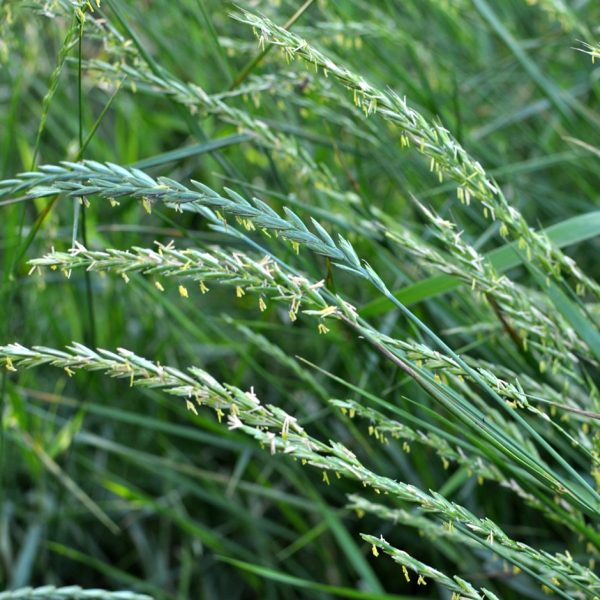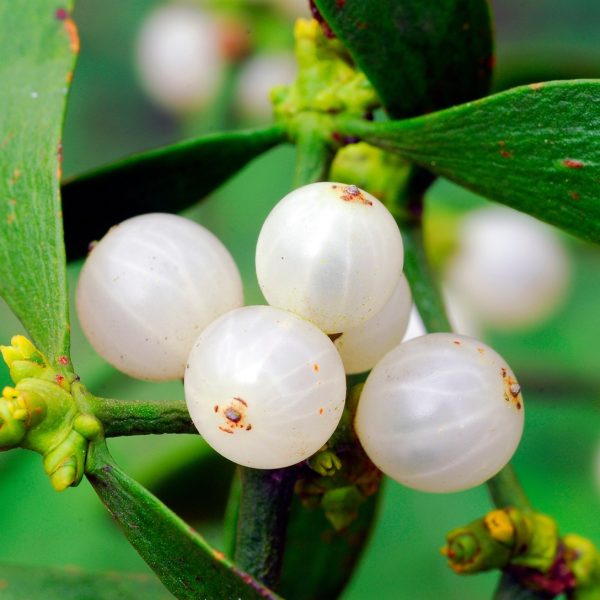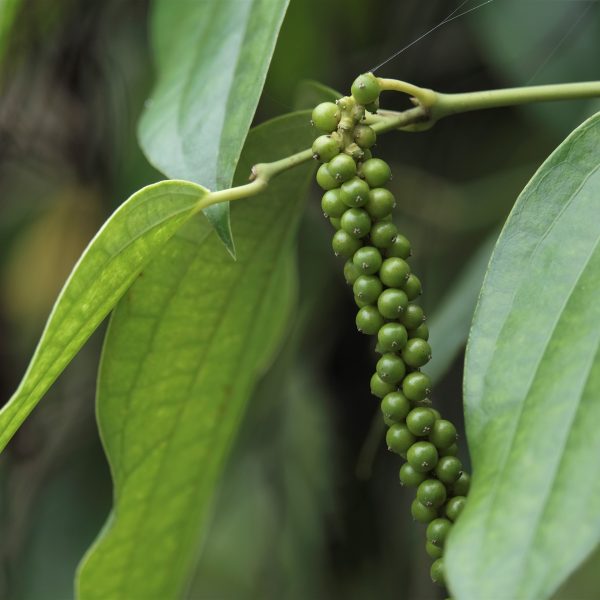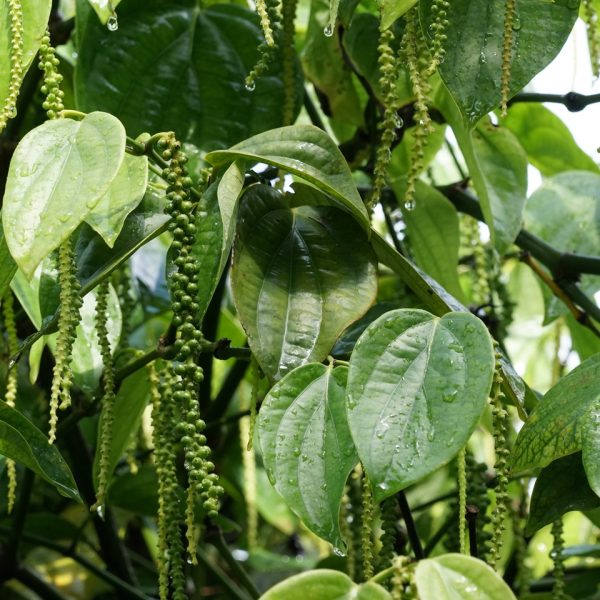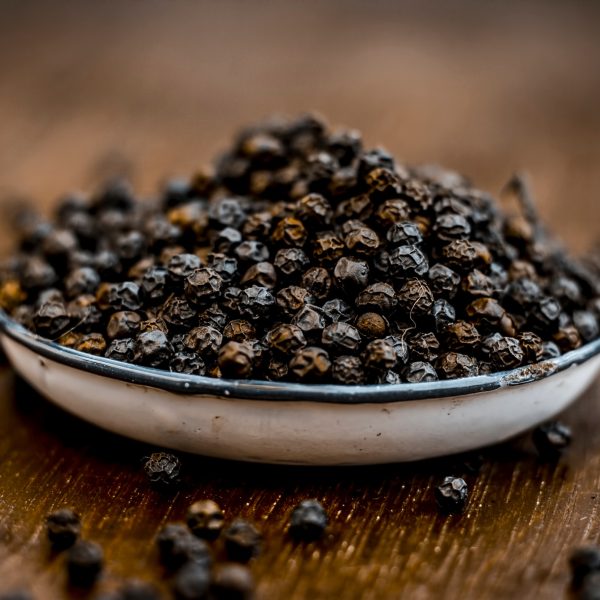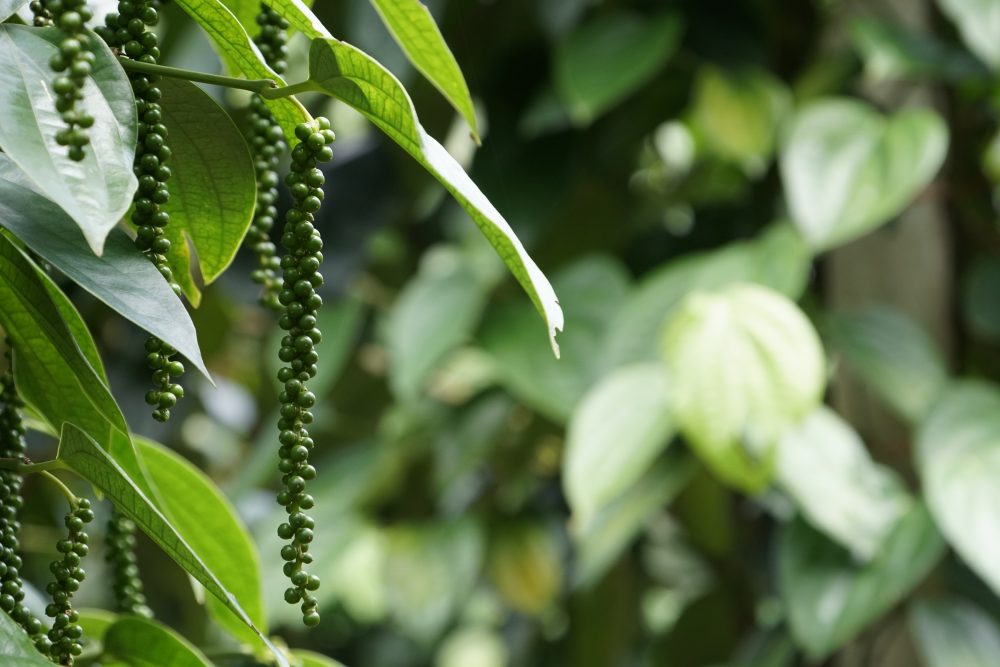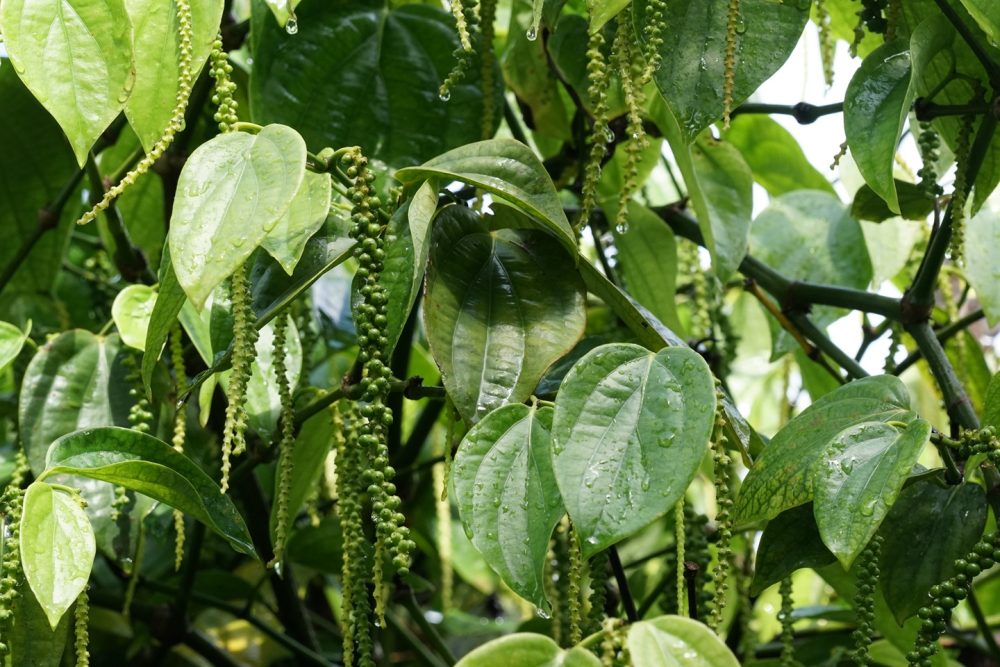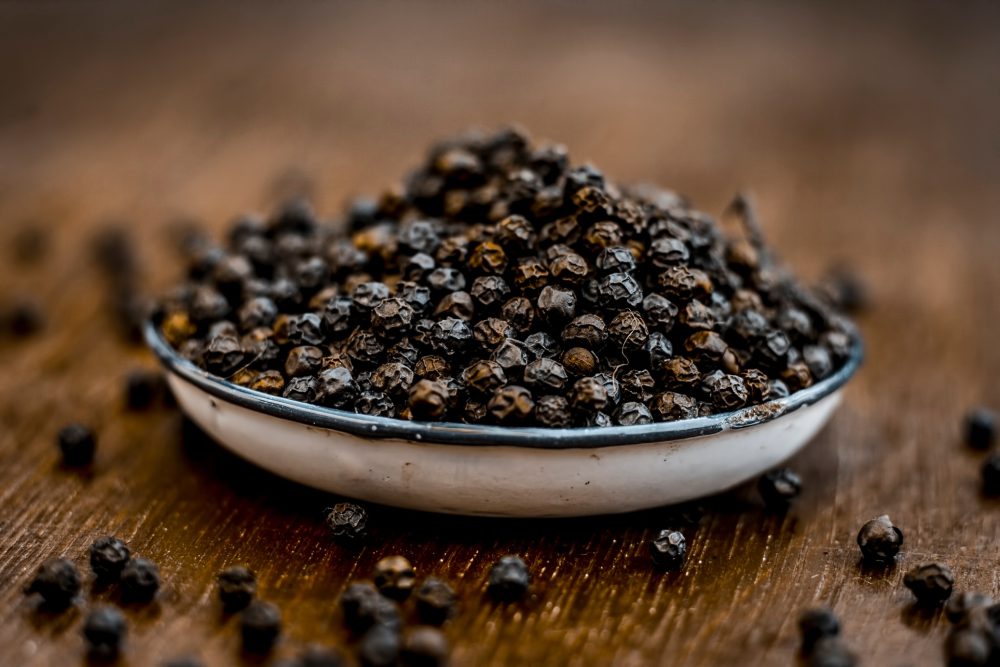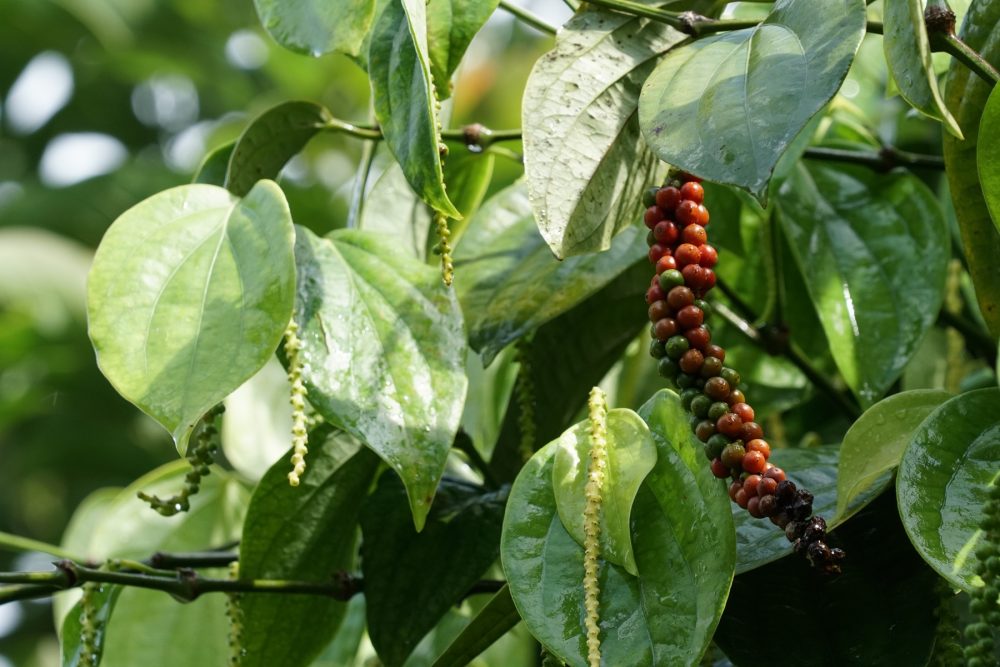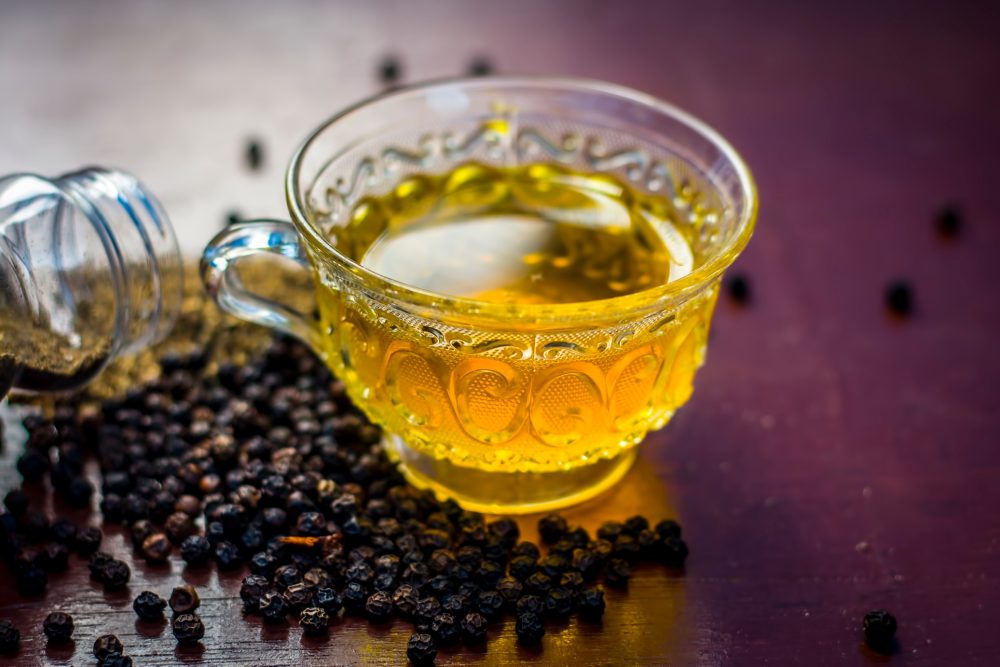-
How does it feel?
As soon as you taste black pepper, there is an immediate feeling of pungency, and a light, spreading nature. The feeling is due to black pepper’s volatile oils stimulating receptors on the pain fibres in the lining of the mouth. The heat originates from the increase in blood flow that results from the stimulation. This increased circulation is both at the site of the stimulation and also throughout the body.
-
What can I use it for?

Black pepper (Piper nigrum) Black pepper is one of the most widely used culinary spices. It is valued for its distinct biting quality attributed to one of its constituents, piperine, as well as food preservation properties. It is also widely used in the herbal tradition, constituting one third of the famous Ayurvedic formula trikatu (along with ginger (Zingiber officinale) and long pepper (Piper longum)). This formula is used to stimulate circulation, digestion and for lung problems accompanied by sticky mucus. In Ayurveda, black pepper is seen as more than a spice — it’s a catalyst for healing, warmth, and vitality.
Many of black pepper’s properties are attributed to an alkaloid constituent known as piperine. Piperine has demonstrated stimulant activity that supports poor circulation and shifts stuck congestion within the respiratory and reproductive systems. Piperine also has the ability to enhance the bioavailability of certain constituents in both conventional and non-conventional medication (1). It increases permeability and partitioning, which can promote rapid absorption from the gastrointestinal tract (GIT). This has made black pepper a valuable herb in cases of malabsorption and/or where there is a lack of digestive metabolism.
The high essential oil content and stimulant nature of piperine also give this herb notable tonifying actions to tissues within the reproductive and respiratory systems, improving their strength and resistance. The pungent constituents within this herb are effective as anthelmintics, targeting gastrointestinal infections (1).
-
Into the heart of black pepper

Black pepper (Piper nigrum) This parasitic creeper grows up host plants and thrives in the humid climates of southwest India and Sri Lanka. The fruit is first green, then red, then yellow and finally goes black on drying. Black pepper is powerfully heating and penetrating, making it excellent for addressing debility and nervous exhaustion of vata dosha and lethargy of kapha dosha.
It acts as a rejuvenative (rasayana) for the respiratory channel, clearing sticky, white mucus and relieving congestion, cough, asthma, bronchitis, pneumonia and sore throats (3).
It clears undigested matter (ama) from the lymphatic tissue, thereby resolving low and chronic fevers associated with kapha dosha. It stimulates blood flow, relieves uterine stagnation and menstrual issues. Being sharp and hot, it increases the digestive fire (agni), so it helps with all vata and kapha dosha digestive problems due to excess cold and damp, as well as anorexia, colic, flatulence, bloating and sluggishness. Black pepper burns ama in the gut, clearing worms and parasites, stimulating the liver and pancreatic function. It stimulates sweating and purifies the skin, so is helpful in skin diseases. It is also useful for oral abscesses and tooth decay.
Its stimulating quality is very powerful and this rajasic quality must be balanced with other sweet herbs or with honey.
-
Traditional uses

Black pepper (Piper nigrum) Black pepper, often called the “King of Spices”, has been revered in both Ayurveda and traditional Chinese medicine (TCM) for thousands of years — not just for its flavour, but for its potent healing properties.
In Ayurveda, its key use is to stimulate the digestive fire (agni), enhancing appetite and nutrient absorption while reducing bloating and gas. Its hot, sharp qualities stimulate salivation.. It clears the deposits of kapha on the tongue and chest, stimulates the liver as well as other digestive fluids. It is the ideal herb for anorexia, indigestion, liver dysfunction and colic. It is also valued for detoxification, where it is used in formulas like trikatu (with ginger and long pepper), to help eliminate toxins (ama) and support metabolism.
When it comes to respiratory support, black pepper is effective in reversing sluggishness of the pranavāha srotas (respiratory channel) and reducing mucus secretions. Its pungency helps clear mucus from the lungs and sinuses, making it a go-to for colds and coughs. It is often traditionally combined with honey to dry moisture and excessive secretions, and help counter its heat. It is also a stimulant for the circulatory system, gradually removing blockages in the small capillaries and supporting blood flow.
For the urinary system, black pepper ameliorates urinary disorders by reducing the viscosity of phlegm and supporting its removal. It also increases the flow of urine by stimulating the blood vessels in the kidneys. It has a similar stimulating action in the reproductive system, useful in menstrual issues and impotency. It also has a long history of external use in Ayurveda on inflamed skin when mixed with oil or used as a poultice (2).
Black pepper is used externally in the form of paste and cream since the time of Charaka Samhita in the 2nd century BC (Charaka Sutrasthana 3/12). For toothache, teeth were brushed with powdered pepper, or a decoction was used for gargling. In comatose patients, inhalation of black pepper was also given. Black pepper oil is used in traditional abhyanga massage for its warming, anti-inflammatory effects.
Ayurveda traditionally uses small doses of black pepper to stimulate the action of other herbs, due to its ability to open up the channels of the body. It facilitates opening of even the narrow channels, encouraging the removal of deep seated kapha dosha. Because of this effect, it has found a place in trikatu, a well respected Ayurvedic formulation.
-
Traditional actions
Herbal actions describe therapeutic changes that occur in the body in response to taking a herb. These actions are used to express how a herb physiologically influences cells, tissues, organs or systems. Clinical observations are traditionally what have defined these actions: an increase in urine output, diuretic; improved wound healing, vulnerary; or a reduction in fever, antipyretic. These descriptors too have become a means to group herbs by their effects on the body — herbs with a nervine action have become the nervines, herbs with a bitter action are the bitters. Recognising herbs as members of these groups provides a preliminary familiarity with their mechanisms from which to then develop an understanding of their affinities and nuance and discern their clinical significance.
Western actions
Ayurvedic actions
Chinese actions
-
Traditional energetic actions
Herbal energetics are the descriptions Herbalists have given to plants, mushrooms, lichens, foods, and some minerals based on the direct experience of how they taste, feel, and work in the body. All traditional health systems use these principles to explain how the environment we live in and absorb, impacts our health. Find out more about traditional energetic actions in our article “An introduction to herbal energetics“.
Ayurvedic energetics
-
What practitioners say
 Black pepper may be usefully applied for a range of digestive, circulatory and respiratory conditions. The modern practitioner can be guided by traditional wisdom and use black pepper in a variety of cases, particularly when symptoms are made worse by cold and damp conditions and seem to be relieved by heat and dryness (4).
Black pepper may be usefully applied for a range of digestive, circulatory and respiratory conditions. The modern practitioner can be guided by traditional wisdom and use black pepper in a variety of cases, particularly when symptoms are made worse by cold and damp conditions and seem to be relieved by heat and dryness (4).Digestive system
Black pepper is useful to support low appetite, sluggish digestion, abdominal pain, toxin excretion and borborygmus. Its hot and penetrating qualities help stimulate the digestive fire (agni) as they increase enzymatic secretions. This helps to enhance absorption of nutrients and reduces any lingering undigested matter (ama). Its affinity for the eliminatory system, along with antiparasitic qualities, helps to expel parasites.
Endocrine system
As black pepper contains chromium, a component of glucose tolerance factor, it is a valuable plant in diabetes treatment. It normalises the fat tissue and prevents ama overflowing into the pancreas and urine.
Additionally, 86 overweight people taking a supplement containing piperine and other compounds for eight weeks experienced significant improvements in insulin sensitivity, a measure of how well the hormone insulin removes glucose from the bloodstream (5). However, it’s unclear whether the same effects would occur with black pepper alone, as a combination of many active plant compounds was used in this study.
Respiratory system
Black pepper is specific for cold, wet, damp kapha conditions in the respiratory channel with white sticky mucus and a productive cough, so is indicated for asthma, bronchitis, pneumonia and sore throats. Black pepper infused with oil or ghee, applied to the nose, can be a wonderful decongestant for blocked sinuses.
Immune system
Black pepper can help to raise the temperature to make the environment inhospitable to pathogens, and induce a sweat to release the misplaced agni that has moved from the stomach to the plasma tissues. It clears undigested matter (ama) from the lymph. It can be used as part of a treatment for intermittent fevers such as malaria when combined with bitter, cooling herbs.
Cardiovascular system
Pepper stimulates microcirculation in the capillaries, useful in cirrhosis, hepatitis and skin diabesity signs of stagnant blood, e.g., red or purple patches and chronic lesions. It can also help with cold congestion in the uterus in cases of dysmenorrhoea and amenorrhoea. An external application of the essential oil in the form of a poultice can help relieve neuralgic and arthritic pain with cold swellings. This can also be used to draw out boils and abscesses. It can also be used as a decoction for sore throats.
-
Research

Black pepper (Piper nigrum) Research has provided compelling support for many of black pepper’s traditional Ayurvedic uses, mainly looking at its key bioactive compound, piperine. However, despite these promising findings, more studies in humans are needed to better understand the exact actions of black pepper.
A systematic review on black pepper: From folk uses to pharmacological applications
A review attempted to systematically review scientific data on the traditional uses, phytochemical composition and pharmacological properties of black pepper (6). Antimicrobial activity was recorded against a wide range of pathogens. Studies also reported its antioxidant effects and improvement of antioxidant enzymes in vivo. It also exhibited an anticancer effect against a number of cell lines from breast, colon, cervical and prostate through different mechanisms, including cytotoxicity, apoptosis, autophagy and interference with signalling pathways.
Its antidiabetic property has also been confirmed in vivo as well as hypolipidemic activity as evidenced by a decrease in the level of cholesterol, triglycerides, and low-density lipoprotein and an increase in high-density lipoprotein. Black pepper also has anti-inflammatory, analgesic, anticonvulsant, and neuroprotective effects. The major bioactive compound is piperine although other compounds are also present including piperic acid, piperlonguminine, pellitorine, piperolein B, piperamide, piperettine, and kusunokinin, which also showed biological potency.
The review looked at 60 pharmacological studies conducted in vitro, with only 21 in vivo and 1 clinical trial. Hence, more in vivo experiments and clinical trials would be beneficial to better understand black pepper’s “panoply of bioactive compounds with potential nutraceutical and pharmaceutical applications” (6).
Permeability characteristics of piperine on oral absorption: n active alkaloid from peppers and a bioavailability enhancer
Piperine is the pungent alkaloid present in both black pepper and long pepper. It is known to significantly increase the absorption of nutrients and herbal compounds like curcumin, which supports its traditional role in Ayurvedic formulations like trikatu (7). One in vitro study explored how it enhances the bioavailability of various structurally and therapeutically diverse drugs, looking specifically at oral absorption using intestinal sacs as an experimental model (8).
Piperine was found to be highly lipophilic in nature, being absorbed through the transcellular pathway. The study’s findings suggest piperine is absorbed quickly across the intestinal barrier and may even modulate membrane dynamics, enhancing permeability across the barriers.
Antiallergic effect of piperine on ovalbumin-induced allergic rhinitis in mice
Chronic inflammation may be an underlying factor in many conditions, with many studies suggesting black pepper may effectively reduce inflammation (9). For example, in studies in rats with arthritis, treatment with piperine resulted in less joint swelling and fewer blood markers of inflammation (10,11). In mouse studies, piperine suppressed inflammation in the airways caused by asthma (12) and seasonal allergies (13).
Allergic rhinitis is a global health problem that affects a large portion of the population. As piperine has been shown to have anti-inflammatory, anti-histaminic, and immunomodulatory activities, this study sought to explore its antiallergic profile in mice. Piperine was shown to have a significant dose-dependent protection with respect to nasal rubbing, redness of the nose, and sneezing, and to reduce histamine.
The study concluded that piperine acts by mast cell-stabilising activity, exhibiting immunomodulatory and anti-inflammatory activity, thereby providing an effective treatment for allergic rhinitis.
Evaluation of analgesic properties of Piper nigrum essential oil
Studies have indicated that the essential oil of black pepper has anti-inflammatory effects. In particular, linalool, a monoterpene, is one component of black pepper essential oil that has demonstrated analgesic properties in preclinical studies. However, little is known about black pepper essential oil beyond these effects, so a randomised, double-blind, placebo-controlled trial sought to evaluate the analgesic properties of black pepper essential oil in patients experiencing pain (14).
Fifty-four patients were randomly divided into two different groups and provided identical-looking vials containing either the experimental oil or the placebo oil. Patients in group A inhaled the black pepper essential oil, while patients in group B inhaled sesame oil, both for 15 minutes. Before and after the treatment, patients were provided a questionnaire where they indicated the intensity and location of the pain. There was a significant difference found between the two groups.
Consistent with preliminary research on the volatile constituents of black pepper, the authors found that inhalation of black pepper essential oil resulted in a significantly lower pain intensity score than the placebo. Due to the small sample size, pain region variability, and unbalanced gender of this trial, more studies are needed to assess differences between gender and pain regions. The results of this study indicate that black pepper essential oil may be a valuable resource for pain management.
-
Did you know?
Black pepper is traditionally used in India to reduce the kapha aggravating effect of sweet fruit juices. It is also used in post-partum care and is included in herbal remedies given to the new mother. Black pepper is added to control vata dosha aggravation that naturally occurs post-delivery.
Additional information
-
Botanical description
Piper nigrum is a perennial vine. The leaves are simple, alternate, oval, leathery and the upper surface is dark green and whitish green below. The flowers are greenish yellow and arranged in a spiral along the spine. Fruit is an oval drupe, green in colour, then becomes yellow to red and finally turns a black colour. The fruit contains a seed (19).
-
Common names
- Common pepper,
- Pepper
- Maricha (Sanskrit)
- Kalimirch (Hindi)
-
Safety
Black pepper has been safely used as a food for many centuries, with few adverse reports in daily cuisine, clinical practice or in clinical trials at a low dose.
As it is heating, no more than 5 g should be given daily over long time periods. A low dose such as those found in food is safe for long-term use. The piperine content of black pepper , when used as an isolated ingredient, has been associated with enhancing blood levels of certain medications e.g., propranolol, theorphylline, refampicin. It may also inhibit drug metabolism in the liver if used over long periods at high doses; hence, all patients taking drugs that are metabolised in the liver must be carefully monitored.
In its whole form, it also increases short-term bioavailability by increasing nutrient absorption and reducing blood levels of medication (15).
Based on centuries of safe use as a food by pregnant women, black pepper appears to be safe for use during pregnancy when taken as a culinary spice; however, it should be avoided in high doses as, in theory, it may have abortifacient effects (2,4,16).
There is limited research as to effects in high doses though one study looked at a culinary dose during breast feeding. Thirteen nursing mothers who were nursing their infants were served a curry dish that contained an average piperine concentration of 264 nmol/gram (75 mcg/gram) in curry sauce. The peak piperine concentration in milk of 31.2 nM (8.9 mcg/L) occurred at one hour after the meal in these mothers with a low basal piperine concentration in milk. The authors assumed the concentration of piperine was too low for conscious detection by the nursing infant, but that it could contribute to a sensory desensitisation toward pungency in later life (17).
-
Interactions
Caution with sedatives, benzopdiazepines, barbiturates. Black pepper increases the absorption and action of medications and analgesic activity of diclofenac and pentazocine (2,4).
-
Contraindications
It can irritate mucous membranes. Avoid in hyperacidity and dryness. Black pepper also aggravates vata dosha in excess (3,4).
-
Preparations
- Powder
- Decoction
- Tincture
- Poultice/ external paste
- Essential oil
-
Dosage
- Tincture (ratio 1:5| 70%): 1–2 ml daily
- Dried: 1–3 g a day
- With ghee / honey for kapha congestion in pranavaha srotas (4)
-
Plant parts used
Fruit
-
Constituents
- Volatile oils: Sabinene, camphene, limonene, myrcene, piperonal, pinene, myrcene, carene
- Monoterpene derivatives: Borneol, carvone, carvacrol, cineol, linalool, caryophyllene, humulene, bisabolone and caryophyllene
- Alkaloids: Piperine, piperdine, piperanine, chavicine and piperettine
- Chromium oxide and ketone
- Phenylethers: Eugenol, myristicin, safrole (18)
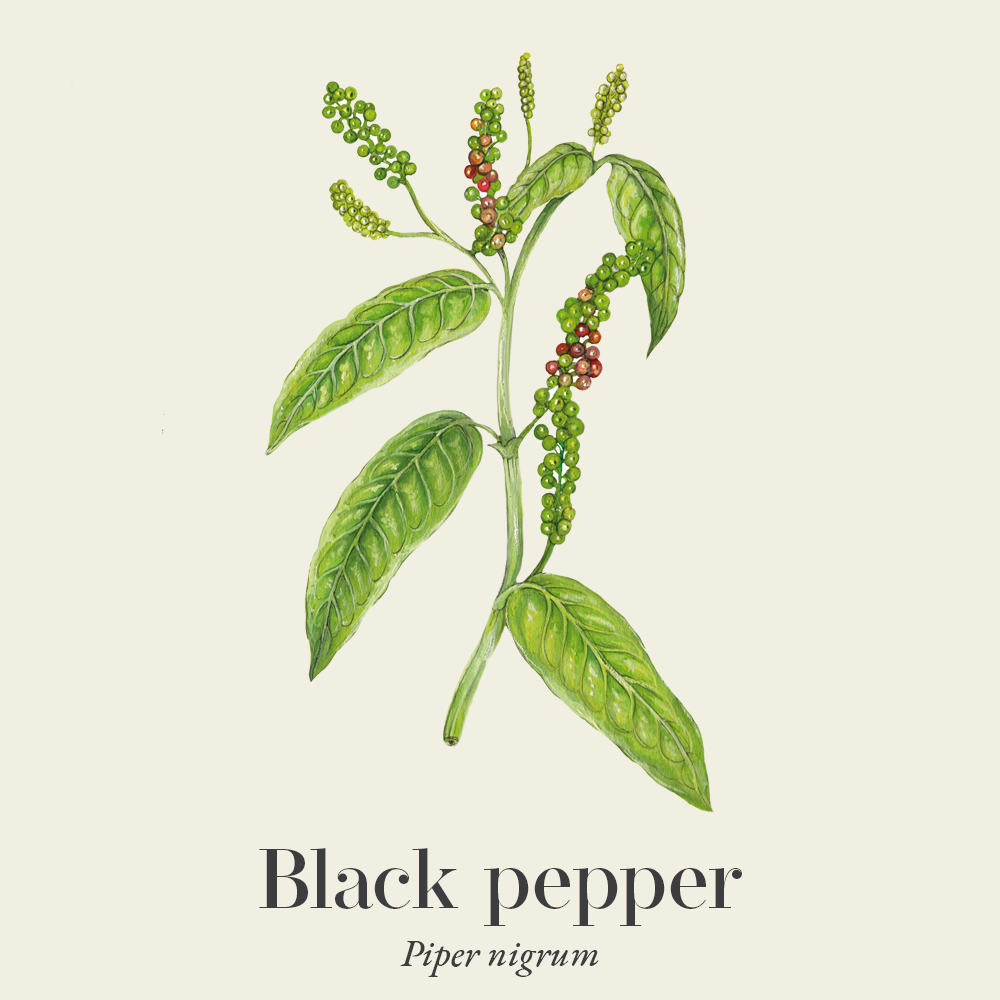
-
Habitat
Cultivated in India, Sri Lanka, Malaysia, Indonesia, West Africa and Madagascar.
In India specifically, it can be found growing on the hills of south-western India. Cultivated in Assam, Karnataka, Maharashtra and Kerala (19). -
Sustainability

Not currently on risk lists but complete data may be missing on the status of the species. Read more in our sustainability guide. Black pepper is one of the most widely used and traded spices in the world. However, its cultivation can have negative environmental impacts if not managed sustainably (20).
Black pepper cultivation typically involves the clearing of land for planting, the use of chemical fertilisers and pesticides, and the intensive use of water. These practices can lead to deforestation, soil erosion, water pollution, and loss of biodiversity. Additionally, the carbon footprint of black pepper farming can be significant due to the use of fossil fuels for machinery and transportation.
To reduce the environmental impact of black pepper farming, farmers can adopt sustainable practices such as agroforestry, organic farming, and water conservation techniques. Agroforestry involves planting trees alongside black pepper vines, which can help reduce soil erosion, provide habitat for wildlife, and sequester carbon dioxide (21).
Habitat loss and over-harvesting from the wild are two of the biggest threats faced by medicinal plant species. There are an increasing number of well-known herbal medicines at risk of extinction. We must, therefore, ensure that we source our medicines with sustainability in mind.
The herb supplement industry is growing at a rapid rate and until recent years a vast majority of medicinal plant produce in global trade was of unknown origin. There are some very real and urgent issues surrounding sustainability in the herb industry. These include environmental factors that affect the medicinal viability of herbs, the safety of the habitats that they are taken from, as well as the welfare of workers in the trade.
The botanical supply chain efforts for improved visibility (transparency and traceability) into verifiably sustainable production sites around the world is now certificated through the emergence of credible international voluntary sustainability standards (VSS).
Read our article on Herbal quality & safety: What to know before you buy and Sustainable sourcing of herbs to learn more about what to look for and questions to ask suppliers about sustainability.
-
Quality control
Herbal medicines are often very safe to take; however, their safety and efficacy can be jeopardised by quality issues. So, it is important to buy herbal medicines from a reputable supplier, from sources known to test their herbs to ensure there is no contamination, adulteration or substitution with incorrect plant matter, as well as ensuring that recognised marker compounds are at appropriate levels in the herbs.
Some important quality assurances to look for are certified organic labelling, the correct scientific/botanical name, and the availability of information from the supplier about ingredient origins. A supplier should be able to tell you where the herbs have come from, what contaminants are not in the herb, and what the primary compounds are.
-
How to grow
Black pepper will thrive in warm and humid climates, ideally between 20–30°C and will not grow in temperatures lower than 21°C. To grow black pepper from seed, soak the seeds beforehand to soften them and increase chances of germination. Sow the seeds in nutrient rich compost, germination will take between 2–4 weeks. Keep the soil moist but not waterlogged and ensure good drainage when they are planted out. Plant the seedlings out once they have reached 15 cm and provide a support structure such as a trellis or stake as it is a climbing vine (22).
-
Recipe

Black pepper tea (Piper nigrum) Weight-balancing tea
When our digestive fire is low it cannot transform food into nourishing energy.
Instead, food can get stored as fat, starting a vicious cycle where digestion becomes weaker and weaker, leading to steady weight gain. This tea stimulates metabolism to help you find your natural and balanced weight. It’s a fiery one.Ingredients
- Cinnamon bark 4 g
- Ginger root powder 2 g
- Orange peel 2 g
- Green tea 2 g
- Turmeric root powder 1 g
- Black pepper 1 g
- Orange essential oil, one drop per cup (we recommend using an essential oil that is specific for internal use)
How to make a black pepper tea
This will serve 2–3 cups of digestion-enhancing, weight-balancing tea that works together with lots of exercise.
- Put all of the ingredients in a pot (except for the orange essential oil).
- Add 500 ml/18 fl oz freshly boiled filtered water.
- Leave to steep for 10–15 minutes, then strain.
- Add one drop of orange essential oil to each cup.
Recipe from Cleanse, Nurture, Restore by Sebastian Pole
-
References
- Srinivasan K. Black pepper and its pungent principle-piperine: a review of diverse physiological effects. Crit Rev Food Sci Nutr. 2007;47(8):735-748. https://doi.org/10.1080/10408390601062054
- Pole S. Ayurvedic Medicine. 2013:237.
- Gogte VM. Ayurvedic Pharmacology and Therapeutic Uses of Medicinal Plants. 1982:460.
- McIntyre A, Boudin B. Dispensing with Tradition. 2012:218. (Note: Publication date corrected from 21012 to 2012)
- Rondanelli M, Opizzi A, Perna S, et al. Improvement in insulin resistance and favourable changes in plasma inflammatory adipokines after weight loss associated with two months’ consumption of a combination of bioactive food ingredients in overweight subjects. Endocrine. 2013;44(2):391-401. https://doi.org/10.1007/s12020-012-9863-0
- Takooree H, Aumeeruddy MZ, Rengasamy KR, et al. A systematic review on black pepper (Piper nigrum L.): from folk uses to pharmacological applications. Crit Rev Food Sci Nutr. 2019;59(sup1):S210-S243. https://doi.org/10.1080/10408398.2019.1565489
- Stojanović-Radić Z, Pejčić M, Dimitrijević M, et al. Piperine—a major principle of black pepper: a review of its bioactivity and studies. Appl Sci. 2019;9(20):4270. https://doi.org/10.3390/app9204270
- Khajuria A, Zutshi U, Bedi KL. Permeability characteristics of piperine on oral absorption—an active alkaloid from peppers and a bioavailability enhancer. Indian J Exp Biol. 1998;36(1):46-50.
- Kunnumakkara AB, Sailo BL, Banik K, et al. Chronic diseases, inflammation, and spices: how are they linked? J Transl Med. 2018;16:14. https://doi.org/10.1186/s12967-018-1381-2
- Bang JS, Oh DH, Choi HM, et al. Anti-inflammatory and antiarthritic effects of piperine in human interleukin 1β-stimulated fibroblast-like synoviocytes and in rat arthritis models. Arthritis Res Ther. 2009;11(2):R49. https://doi.org/10.1186/ar2662
- Umar S, Sarwar AHMG, Umar K, et al. Piperine ameliorates oxidative stress, inflammation and histological outcome in collagen induced arthritis. Cell Immunol. 2013;284(1-2):51-59. https://doi.org/10.1016/j.cellimm.2013.07.004
- Kim SH, Lee YC. Piperine inhibits eosinophil infiltration and airway hyperresponsiveness by suppressing T cell activity and Th2 cytokine production in the ovalbumin-induced asthma model. J Pharm Pharmacol. 2009;61(3):353-359. https://doi.org/10.1211/jpp/61.03.0010
- Aswar U, Shintre S, Chepurwar S, Aswar M. Antiallergic effect of piperine on ovalbumin-induced allergic rhinitis in mice. Pharm Biol. 2015;53(9):1358-1366. https://doi.org/10.3109/13880209.2014.982299
- Costa R, Machado J, Abreu C. Evaluation of analgesic properties of Piper nigrum essential oil: a randomized, double-blind, placebo-controlled study. World J Tradit Chin Med. 2016;2(2):60-64. (DOI not currently available)
- Ren T, Zuo Z. Role of piperine in CNS diseases: pharmacodynamics, pharmacokinetics and drug interactions. Expert Opin Drug Metab Toxicol. 2019;15(10):849-867. https://doi.org/10.1080/17425255.2019.1672658
- Natural Medicines Database. Black pepper. Therapeuticresearch.com. Published 2025. Accessed July 9, 2025. https://naturalmedicines.therapeuticresearch.com/Data/ProMonographs/Black-Pepper
- Drugs and Lactation Database (LactMed®) [Internet]. Bethesda, MD: National Institute of Child Health and Human Development; 2006–. Black Pepper. Updated January 15, 2025. Available from: https://www.ncbi.nlm.nih.gov/books/NBK579035/
- Ashokkumar K, Murugan M, Dhanya MK, Pandian A, Warkentin TD. Phytochemistry and therapeutic potential of black pepper [Piper nigrum (L.)] essential oil and piperine: a review. Clin Phytosci. 2021;7(1):23. https://doi.org/10.1186/s40816-021-00292-2
- Editors of Encyclopaedia Britannica. Black pepper | Plant, Cultivation, & Description. In: Encyclopaedia Britannica. 2020. https://www.britannica.com/plant/black-pepper-plant
- Ess Team. Sustainability in black pepper farming: reducing environmental impact and enhancing soil health. Published March 17, 2025. (Additional publication details not available.)
- Vernick D. Sustainable pepper farming supports people and nature in Malaysian Borneo. World Wildlife Fund. Published November 17, 2020. https://www.worldwildlife.org/stories/sustainable-pepper-farming-supports-people-and-nature-in-malaysian-borneo
- Gardening Know How. Black peppercorn. Published 2025. https://www.gardeningknowhow.com/edible/herbs/peppercorn/how-to-grow-peppercorns.htm


